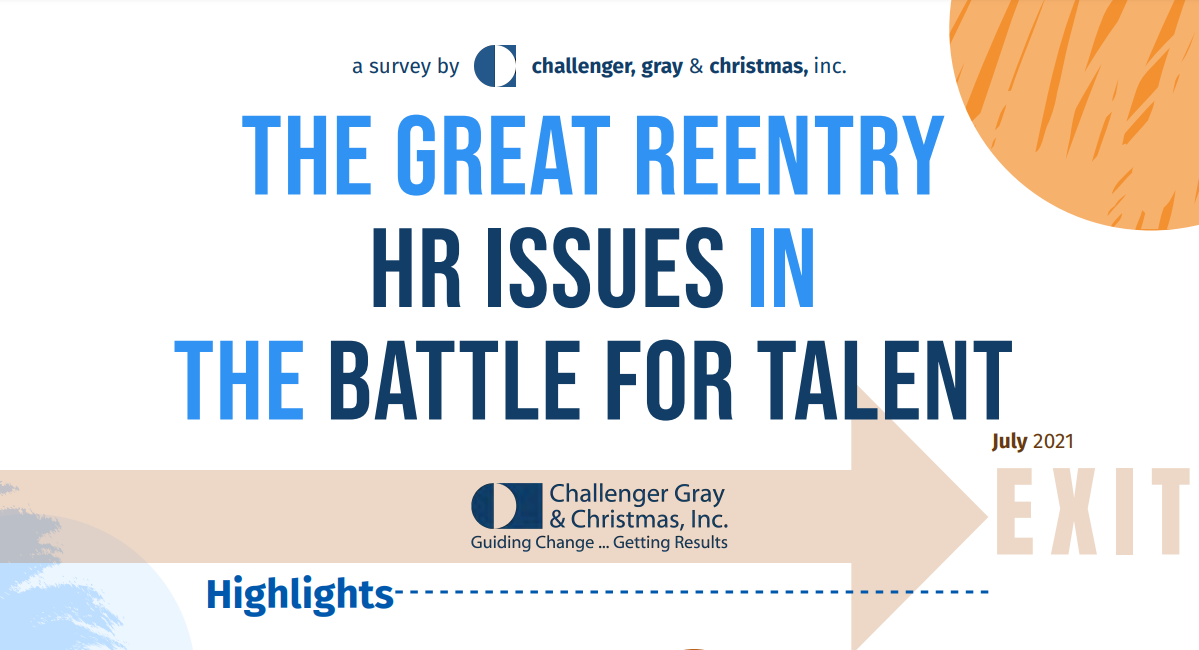Challenger recently conducted a survey which shows the concern most HR execs and business leaders have about an exodus of their talent. This coincides with a very high quits rate and reported labor shortage. 85% of companies reported they were having trouble filling positions in our survey, and 81% of companies are experiencing pushback to return to the office.
Survey Results: The Great ReEntry or The Great Resign?
Aug 5, 2021 12:44:08 PM / by Kevin Legara posted in Uncategorized
Turnover ‘Tsunami’ Expected Once Pandemic Ends
Apr 14, 2021 3:48:37 PM / by Kevin Legara posted in Uncategorized
More than 50% of employees surveyed in North America plan to look for a new job in 2021
If you have a staffing role in your organization…now would be a good time to hit the panic button.
The big question is why… and why now?
As you may recall, before the pandemic kept workers out of their offices and in their homes, employers were seeing high turnover rates… but the pandemic put a halt to much of that. In fact, ‘quitting rates’ reached their lowest level in nine years during the pandemic. People hunkered down at home and held on to the jobs they had. Now, as Spring flowers are blooming… so are workers aspirations to find a better job.
Expect more job openings as well, according to the Work Institute in Franklin, TN.
According to research from Achievers Workforce Institute (an employee recognition software company in Toronto), of 2000 employed adults surveyed in Feb 2021…
- 52% are looking for a new job… up from 35% a year ago
- 46% feel less connected to their company
- 42% say company culture has diminished in the past year
- Only 21% said they are very engaged at work
Some reasons’ respondents shared for wanting a new job included…
- 35% said better compensation and benefits
- 25% said better life/work balance
- And burnout was also a major factor
While working at home may provide some additional flexibility, apparently wearing sweatpants to work doesn’t equate to a better work/life balance.
The studies showed that employees worry that their manager doubts their at-home productivity… to make up for that doubt, 40% of workers are either starting their workday earlier… or staying at it later, or BOTH… and more than a third are skipping lunch breaks to appear more productive to doubting managers.
People like to feel that their work is appreciated.
People like to be heard in the workplace.
Reach out to FutureSolve and let us help you create the best plan for engagement and retention which would include a strong recognition plan, A.I People Analytics, and organization alignment on purpose and the mission.
Written By:
Jacque Busby
4 key work trends to be prepared for in 2021
1) Exodus– The potential difficulty of holding on to key employees as things begin to open up again.
2) Inclusion-The importance of having a clear position and effective practices to enable inclusion in the workplace.
3) Performance Enablement-New skills will be needed at all levels of organizations.
4) Respect–Sounds simple; but companies will pay a price where treating people with respect is not a core part of their culture.
HCM Technology Trends
Feb 3, 2021 7:26:22 AM / by Jonathan Webster posted in Uncategorized
Watch out for these HCM Technology trends in 2021
Let us first talk about some trends in the workplace that have emerged post the pandemic and see how these are impacting HCM technology
1. Hybrid workplace model
We are seeing the emergence of the ‘Hybrid workplace’ model with employers and employees experiencing benefits from the blended ‘work from anywhere’ option. As physical offices have started to open, many companies have announced a permanent work from home option as well. Organizations are transforming their practices, processes and policies towards employees as the focus has now shifted from the employer to the employee. This new model is challenging HCM players to adapt, develop and accelerate to what I call as ‘Exponential HCM technology’ that asks them ‘how nimble they are’? how adaptable they are? and how flexible they are?
2. Re-skilling and Learning in the flow of work
We have seen companies accelerating their digital transformation process in the pandemic. In the bargain many tasks that do not require human intervention have been automated. Likewise, job roles have changed given the new operating circumstances. A study by Edelman found that 49% of employees now believe automation and re-skilling are their biggest threats at work. Enterprises have seen a huge uptake in consumption of ‘learning platforms’ during the pandemic. The challenges of ‘learning and re-skilling’ will have a huge impact on HCM platforms as the new mantra is ‘learning in the flow of work’
3. Diversity, Equity and Inclusion (DEI)
DEI is now being discussed at the board-level, as laws in many countries now mandate disclosures in this area. Diversity hiring, reporting, tracking, and tools that identify non-diverse talent practices are now mainstream. There have been several start-ups in the past 12 months that have solutions in the DEI space. This is another reason for ‘Exponential HCM technology’ as traditionally HCM platforms were not designed to meet DEI standards of various countries
4. Alternative workforce comprising of Gig and contingent workers becoming mainstream
As per some research reports, over 40% of the U.S. workforce is employed in an alternative arrangement. And over 66% of millennials practice side-hustles or Gigs. We are moving into an era where an employee could have multiple employers. HCM platforms are not designed to manage the alternative and Gig workforce. They will have to develop new capabilities to manage this changing trend in the workforce
5. Employee engagement and well-being taking center stage
The ‘work from anywhere’ model has brought with it challenges for organizations who need to transform the way they engage with employees and look out for their well-being. Employee engagement and well-being tools, recognition, and other platforms to help employers regularly monitor the health, safety and happiness of their workforce have taken center stage.
Given these trends in the workplace, there is tremendous pressure on HCM platforms to re-look at their roadmap, fast track relevant new capabilities and make things happen. This has set the pace for ‘HCM Technology trends in 2021’.
HCM Technology Trends 2021
1. For HCM platforms their core business of HRMS and Payroll is complex enough, therefore, we are likely to see many more acquisitions of disruptive talent & employee experience applications in recruiting, learning, performance management, engagement, well-being and so on.
We saw the mega acquisition of Qualtrics by SAP in 2019 and many more in 2020. Some of the acquisitions in the US included, Paylocity and Samepage – an all-in-one team collaboration solution, Justworks and Boomr – a leading cloud-based Time and Attendance solution, Paycor and 7Geese – a leader in goal setting and performance management.
We will see many more acquisitions and white labelled deals in 2021. We can expect significant venture funding in HCM platforms given the need to rapidly expand their offerings for a hybrid workplace with the related workplace issues we discussed earlier.
2. HCM platforms will need an open architecture to integrate the ecosystem of innovative apps in HRTech and WorkTech being used by their customers.
Firstly, we spoke about several ‘best of breed’ niche players in Talent acquisition, Engagement, Performance management, Learning, Rewards, and so on. Customers will continue to buy best of breed given that they offer considerable depth as against the HCM platforms that may have a width of offerings but limited depth. Enterprise customers are looking for specialist platforms to address specific pain points, so this investment trend will continue.
Secondly, the emerging trend of integrating HRTech into WorkTech is something we need to watch out for. WorkTech is a combination of three main spaces: HRTech (Tech for managing & empowering employees.), Collaboration (Tech for operating the workplace eg: Teams, Zoom, Slack, Storage solutions etc), and Productivity (Tech needed to perform tasks and measure productivity eg: Salesforce, other CRM tools, Trello).
Thirdly, the emergence of WorkTech has also brought the big players into the scheme of things. Most of the other enterprise software companies have now started building systems for HR, because the line between HR software and workforce productivity software is getting thinner. We have examples of Microsoft (Linkedin, Glint), Facebook (Workplace by Facebook), Salesforce (Trailhead learning platform).
These trends are forcing HCM suites to take an ecosystem approach that necessitates an open architecture that is easily integrated. As per Josh Bersin, “HR has to be a feature of the work, not a destination outside of the work,”
3. HCM platforms will need to provide a data analytics layer to present a consolidated dashboard for decision making across these multiple HRTech solutions.
“Well, Data is the new Fuel”. Having said that, it comes with its own set of challenges. And therefore, Data analytics and Insights could be the next frontier.
In my conversation with several CHROs, one of the main points that emerged was,
- Enterprises are using so many niche HR Tech solutions (10 or more) apart from having an HCM. Each of these have a dashboard and it is getting challenging not to have a consolidated view and able to draw insights corelating data between these systems.
- Can an HCM integrate with these niche players and present their data in a meaningful manner with actionable insights in ‘Simple English’ or the local language
- The challenge sometimes is of data overload and the inability of executives to analyse, draw insights, predict trends and develop action plans
Are HCM platforms up to the challenge?
I was speaking with Activ 8, a Data Analytics and Insights platform out of the UK, and they echoed this same sentiment. Seeing an opportunity, they have started this play of drawing data from various systems using the HCM as the basic platform to get all this data in. Their engine in turn delivers the relevant insights, trends, and action planning to make it impactful and meaningful for the enterprise leadership.
Having this data analytics engine (either built in) or integrated with a best of breed 3rd party is a clear HCM trend emerging and of great relevance.
4. All progressive HCM platforms will have to be ‘mobile first’ to improve user experience, become a platform in the ‘flow of work’ and drive adoption at the organization level
- Millennials are a mobile only generation using several other apps. Thy will want a similar experience from business apps as well.
- In international markets where laptops are expensive, and the mobile is ubiquitous, it will have to be a mobile first approach
- From a technology standpoint, we also have to recognize that employees want “mobile first” solutions. (the workforce spends 3.6 hours per day on the mobile according to Bond Internet Trends). The traditional HR software model, in which companies first built web-based systems and then added a mobile app, is going away. Most startups in HCM will clearly take this approach. In fact, some may take a ‘mobile only’ model.
- Voice is the next big disruption for users of applications. Today more than 40 million households have Alexa or Google listening devices, and there are more than 100,000 Alexa “skills”. We should assume that HR tools will be accessed by voice on our phone and not on our laptops
5. HCM players will need to provide actionable intelligence by using AI to leverage ‘aggregated data’ from their massive user base to provide industry metrics and useful insights to their clients.
- Enterprises are looking for industry standards all the time. Looking outside of HR, everyone wants to know at an industry level retention rates, churn rates, consumption rates and so on. Likewise, in HR we would be interested to know for our industry- salary benchmarks, attrition rates, employee cost for specific roles and so on.
- Therefore, the ability of HCM to use aggregated data and deliver on these metrics becomes important
- ADP introduced enhancements to its DataCloud platform to help employers address some of the more complex issues they face. Customers now have the ability to benchmark their organization’s data against broader information that’s gathered anonymously from some 740,000 companies.
This will be the norm and not the exception as HCM platforms continue to evolve from the operational and experiential into decision making solutions.
Finally, we want to talk about the opportunities for HCM players in the SMB space.
- The SMB market offers a significant opportunity worldwide. Global players will struggle to address this market given the extent of localization and support required for their products
- There will be a mushrooming of local players to address this growing opportunity with plenty of VC investment available to leverage this market
- The advantage that SMB players also have is a limited threat from niche HRTech tools given that SMBs may not be looking for great depth in niche areas and are likely to be satisfied with generic capabilities being provided by the HCM
So, watch out for plenty of HCM action in the SMB space in 2021.
Building a Diverse Talent Pipeline at the Top: Research and Recommendations
Oct 7, 2020 10:47:37 AM / by Ken Carrig posted in Uncategorized
Numerous studies validate the value of C-Suite diversity: enhanced profitability, innovation and reputation. And as former Chief Human Resources Officer (CHRO) of SunTrust Banks, Sysco, Comcast, Continental Airlines, and PepsiCo, I experienced the value of building a diverse team of top leaders.
So why aren’t more companies developing a diverse senior executive pipeline?
Leadership Practices in Down Economic Conditions
Sep 1, 2020 10:56:51 AM / by Jonathan Webster posted in Uncategorized
Common Response to Economic Downturn
- Survival Mode
- Control
- Panic
Leadership Response to Economic Downturn
- Opportunity
- Involvement
- Focus
Preventing Stress in the Workplace
Sep 1, 2020 10:36:56 AM / by wp-admin-fs posted in Uncategorized
Stress is your body’s automatic response to a danger or demand. Muscles tighten, blood pressure rises, the heart speeds up, and extra adrenaline rushes through your system. This reaction is an age-old survival response. Its purpose is to give the extra strength needed to fight off danger – or to flee from it. It has also been defined as the “rate of wear and tear within the body.” Everyone feels the effects of stress. Stress comes in three forms – physical, emotional, and mental. You, in turn, are affected by stress in all three of – these areas. Stress is a fact of life and some stress can be good for you, because it inspires you to better meet life’s challenges. But too much stress can harm your physical and mental well-being. That’s why you need to be able to control stress – so that ii doesn’t control you.
You cannot eliminate stress but you can manage it. You can minimize the negative impact these types of situations have on you. To take control of the stressors in your life, you need to understand how the stressors affect you. Unless you take time to relax, tensions and pressures build up in your body. Over time this build up of tension will take it’s toll on your body as well as your thinking and emotional well-being. Some of the typical long term ways stress can affect the body are ulcers, high blood pressure, heart attacks and strokes. However, it is the daily stress that builds up to these. Some of the ways that stress shows itself, are sweaty palms, dry mouth,.-stomach trouble, heartburn, tension headaches and restlessness. Once you understand how stress affects you, finding the source can be easy. Some symptoms are easy to overlook.
Listed below are some of the more common signs:
SIGNS OF STRESS
- Hands are cold when no one else’s are.
- Easily upset by things you have no control over, such as traffic.
- You feel rushed and impatient, talking quickly.
- You clinch your jaw muscles.
- You feel burned out or tired all the time.
Stress occurs in every Continental work location and in every job position. Stress can occur during the performance of normal daily tasks or from special situations. All stress isn’t bad. Think about it, when you are faced with a seemingly overwhelming number of things to do, you are forced to set priorities . You stretch yourself and are able to increase the amount you are capable of accomplishing. You can learn to manage your stress and improve the quality of your life by control. However, you must identify what causes your stress at work, home, or in your environment. The top three overall stressors in our lives are death of a loved one, divorce and public speaking. Some others are:
ON THE JOB
- Pressure to meet deadlines / arrival and departure
times. - Too much / little work.
- Angry customer.
- Conflict with your boss or co-workers.
- Equipment failures.
- Job changes.
IN YOUR PERSONAL LIFE
- Low self-esteem.
- Wedding/Divorce.
- Sickness or death.
- Money problems.
- Children.
IN YOUR ENVIRONMENT
- Weather.
- Noise levels.
- Your surroundings.
These are just a few of the situations that can cause stress. Stress affects people in different ways. The key is to reduce the negative results of too much stress. You can learn to manage your stress and improve the quality of your life. Remember that there is good stress, so focus on the stress that is negative in your life and take steps to manage it.
Of course, it’s not realistic to think you can get rid of all stress. Life would be dull and boring without some stress. However, there are ways in which you can learn to control stress rather than to have stress control you. Work the control methods into daily work habits to help reduce stress.
- EXERCISE – Is a great way to relieve physical and mental stress. Studies show that during exercise, chemicals are released that have a tranquilizing affect on the body. Consider jogging, walking, swimming, bicycling or skiing. Ask your physician what the best exercise for your stress would be. Regular exercise will help with the reduction of stress.
- DEEP BREATHING – Is one of the most effective ways to help reduce stress. The way we breath affects the muscles and tensions we have as well as the way in which we think. When things start to get stressful take a moment, think about the situation then take a few deep breaths while you think about how you plan to deal with it.
- SET ASIDE TIME – Doing something that you really enjoy and doing it regularly can help you reduce stress. Balance work with play. Give some priority to recreational activities, and diversions in order to prevent “burnout.” Don’t forget SLEEP, it is one of the best stress reducers around. Getting the proper amount of sleep will recharge your mental and physical batteries and make a world of difference. Take time out and schedule hobbies that you enjoy, painting, fishing,
gardening, cooking, etc. - LAUGH – Laughter may be the best medicine for stress. Try to substitute your stressful thoughts with humorous ones. Look at the big picture and see how humorous it could be. Spend more time with the people who make you laugh. If you can see your favorite comedy, take time out to do so.
- GET HELP – You can always contact a friend, or people who have been in the same situation and ask for their advice. Sometimes just getting it out will help you deal with the stress. If your organization has one, you can contact the E.A.P. program in your area for additional help.
- CHANGE – Sometimes the best thing to do is: “Change the things you can, accept those things you can’t change and have the wisdom to know the difference between the two.”
Remember that stress is an everyday occurrence in everyone’s life. You cannot get away from stress, so take some time out of your day to deal with the stress. The little bit of time you spend now could save you a lot of time in the future. So know the signs of stress on your body, find out what is causing them and then take action to control the stress and don’t let it control you.






